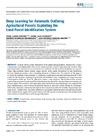Identificador persistente para citar o vincular este elemento:
https://accedacris.ulpgc.es/jspui/handle/10553/70722
| Campo DC | Valor | idioma |
|---|---|---|
| dc.contributor.author | García-Pedrero, Ángel | en_US |
| dc.contributor.author | Lillo-Saavedra, Mario | en_US |
| dc.contributor.author | Rodríguez Esparragón, Dionisio | en_US |
| dc.contributor.author | Gonzalo Martin,Consuelo | en_US |
| dc.date.accessioned | 2020-03-06T13:22:01Z | - |
| dc.date.available | 2020-03-06T13:22:01Z | - |
| dc.date.issued | 2019 | en_US |
| dc.identifier.issn | 2169-3536 | en_US |
| dc.identifier.uri | https://accedacris.ulpgc.es/handle/10553/70722 | - |
| dc.description.abstract | Accurate and up-to-date information on the spatial and geographical characteristics of agricultural areas is an indispensable value for the various activities related to agriculture and research. Most agricultural studies and policies are carried out at the field level, for which precise boundaries are required. Today, high-resolution remote sensing images provide useful spatial information for plot delineation; however, manual processing is time-consuming and prone to human error. The objective of this paper is to explore the potential of deep learning (DL) approach, in particular a convolutional neural network (CNN) model, for the automatic outlining of agricultural plot boundaries from orthophotos over large areas with a heterogeneous landscape. Since DL approaches require a large amount of labeled data to learn, we have exploited the open data from the Land Parcel Identification System (LPIS) from the Chartered Community of Navarre, Spain. The boundaries of the agricultural plots obtained from our methodology were compared with those obtained using a state-of-the-art methodology known as gPb-UCM (global probability of boundary followed by ultrametric contour map) through an error measurement called the boundary displacement error index (BDE). In BDE terms, the results obtained by our method outperform those obtained from the gPb-UCM method. In this regard, CNN models trained with LPIS data are a useful and powerful tool that would reduce intensive manual labor in outlining agricultural plots. | en_US |
| dc.language | eng | en_US |
| dc.relation.ispartof | IEEE Access | en_US |
| dc.source | IEEE Access [ISSN 2169-3536], v. 7, p. 158223-158236 | en_US |
| dc.subject | 250616 Teledetección (Geología) | en_US |
| dc.subject.other | Convolutional neural network | en_US |
| dc.subject.other | Deep learning | en_US |
| dc.subject.other | Edge extraction | en_US |
| dc.subject.other | Land parcel identification system | en_US |
| dc.subject.other | Parcels delineation | en_US |
| dc.title | Deep Learning for Automatic Outlining Agricultural Parcels: Exploiting the Land Parcel Identification System | en_US |
| dc.type | info:eu-repo/semantics/article | en_US |
| dc.type | Article | en_US |
| dc.identifier.doi | 10.1109/ACCESS.2019.2950371 | en_US |
| dc.investigacion | Ciencias | en_US |
| dc.type2 | Artículo | en_US |
| dc.utils.revision | Sí | en_US |
| dc.identifier.ulpgc | Sí | es |
| dc.description.sjr | 0,775 | |
| dc.description.jcr | 3,745 | |
| dc.description.sjrq | Q1 | |
| dc.description.jcrq | Q1 | |
| dc.description.scie | SCIE | |
| item.grantfulltext | open | - |
| item.fulltext | Con texto completo | - |
| crisitem.author.dept | GIR IOCAG: Procesado de Imágenes y Teledetección | - |
| crisitem.author.dept | IU de Oceanografía y Cambio Global | - |
| crisitem.author.dept | Departamento de Señales y Comunicaciones | - |
| crisitem.author.orcid | 0000-0002-4542-2501 | - |
| crisitem.author.parentorg | IU de Oceanografía y Cambio Global | - |
| crisitem.author.fullName | Rodríguez Esparragón, Dionisio | - |
| crisitem.author.fullName | Gonzalo Martin,Consuelo | - |
| Colección: | Artículos | |
Citas de WEB OF SCIENCETM
Citations
49
actualizado el 08-jun-2025
Visitas 5
327
actualizado el 13-dic-2025
Descargas
1.477
actualizado el 13-dic-2025
Google ScholarTM
Verifica
Altmetric
Comparte
Exporta metadatos
Los elementos en ULPGC accedaCRIS están protegidos por derechos de autor con todos los derechos reservados, a menos que se indique lo contrario.
